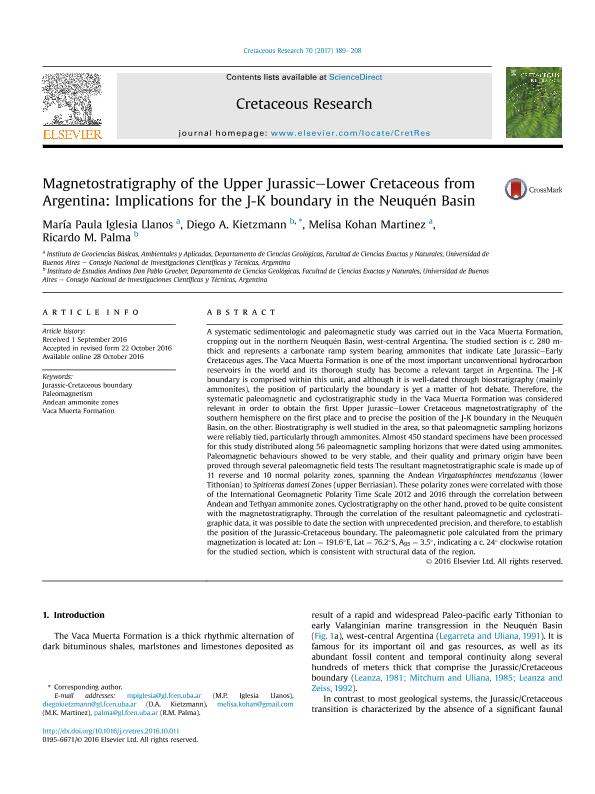Mostrar el registro sencillo del ítem
dc.contributor.author
Iglesia Llanos, Maria Paula

dc.contributor.author
Kietzmann, Diego Alejandro

dc.contributor.author
Kohan Martinez, Melisa

dc.contributor.author
Palma, Ricardo Manuel

dc.date.available
2018-09-19T20:09:53Z
dc.date.issued
2017-02
dc.identifier.citation
Iglesia Llanos, Maria Paula; Kietzmann, Diego Alejandro; Kohan Martinez, Melisa; Palma, Ricardo Manuel; Magnetostratigraphy of the Upper Jurassic–Lower Cretaceous from Argentina: Implications for the J-K boundary in the Neuquén Basin; Academic Press Ltd - Elsevier Science Ltd; Cretaceous Research; 70; 2-2017; 189-208
dc.identifier.issn
0195-6671
dc.identifier.uri
http://hdl.handle.net/11336/60358
dc.description.abstract
A systematic sedimentologic and paleomagnetic study was carried out in the Vaca Muerta Formation, cropping out in the northern Neuquén Basin, west-central Argentina. The studied section is c. 280 m-thick and represents a carbonate ramp system bearing ammonites that indicate Late Jurassic–Early Cretaceous ages. The Vaca Muerta Formation is one of the most important unconventional hydrocarbon reservoirs in the world and its thorough study has become a relevant target in Argentina. The J-K boundary is comprised within this unit, and although it is well-dated through biostratigraphy (mainly ammonites), the position of particularly the boundary is yet a matter of hot debate. Therefore, the systematic paleomagnetic and cyclostratigraphic study in the Vaca Muerta Formation was considered relevant in order to obtain the first Upper Jurassic–Lower Cretaceous magnetostratigraphy of the southern hemisphere on the first place and to precise the position of the J-K boundary in the Neuquén Basin, on the other. Biostratigraphy is well studied in the area, so that paleomagnetic sampling horizons were reliably tied, particularly through ammonites. Almost 450 standard specimens have been processed for this study distributed along 56 paleomagnetic sampling horizons that were dated using ammonites. Paleomagnetic behaviours showed to be very stable, and their quality and primary origin have been proved through several paleomagnetic field tests The resultant magnetostratigraphic scale is made up of 11 reverse and 10 normal polarity zones, spanning the Andean Virgatosphinctes mendozanus (lower Tithonian) to Spiticeras damesi Zones (upper Berriasian). These polarity zones were correlated with those of the International Geomagnetic Polarity Time Scale 2012 and 2016 through the correlation between Andean and Tethyan ammonite zones. Cyclostratigraphy on the other hand, proved to be quite consistent with the magnetostratigraphy. Through the correlation of the resultant paleomagnetic and cyclostratigraphic data, it was possible to date the section with unprecedented precision, and therefore, to establish the position of the Jurassic-Cretaceous boundary. The paleomagnetic pole calculated from the primary magnetization is located at: Lon = 191.6°E, Lat = 76.2°S, A95 = 3.5°, indicating a c. 24° clockwise rotation for the studied section, which is consistent with structural data of the region.
dc.format
application/pdf
dc.language.iso
eng
dc.publisher
Academic Press Ltd - Elsevier Science Ltd

dc.rights
info:eu-repo/semantics/openAccess
dc.rights.uri
https://creativecommons.org/licenses/by-nc-sa/2.5/ar/
dc.subject
Andean Ammonite Zones
dc.subject
Jurassic-Cretaceous Boundary
dc.subject
Paleomagnetism
dc.subject
Vaca Muerta Formation
dc.subject.classification
Meteorología y Ciencias Atmosféricas

dc.subject.classification
Ciencias de la Tierra y relacionadas con el Medio Ambiente

dc.subject.classification
CIENCIAS NATURALES Y EXACTAS

dc.title
Magnetostratigraphy of the Upper Jurassic–Lower Cretaceous from Argentina: Implications for the J-K boundary in the Neuquén Basin
dc.type
info:eu-repo/semantics/article
dc.type
info:ar-repo/semantics/artículo
dc.type
info:eu-repo/semantics/publishedVersion
dc.date.updated
2018-09-18T14:12:42Z
dc.journal.volume
70
dc.journal.pagination
189-208
dc.journal.pais
Países Bajos

dc.journal.ciudad
Amsterdam
dc.description.fil
Fil: Iglesia Llanos, Maria Paula. Consejo Nacional de Investigaciones Científicas y Técnicas; Argentina. Universidad de Buenos Aires. Facultad de Ciencias Exactas y Naturales. Departamento de Ciencias Geológicas; Argentina
dc.description.fil
Fil: Kietzmann, Diego Alejandro. Consejo Nacional de Investigaciones Científicas y Técnicas. Oficina de Coordinación Administrativa Ciudad Universitaria. Instituto de Estudios Andinos "Don Pablo Groeber". Universidad de Buenos Aires. Facultad de Ciencias Exactas y Naturales. Instituto de Estudios Andinos "Don Pablo Groeber"; Argentina
dc.description.fil
Fil: Kohan Martinez, Melisa. Consejo Nacional de Investigaciones Científicas y Técnicas; Argentina. Universidad de Buenos Aires. Facultad de Ciencias Exactas y Naturales. Departamento de Ciencias Geológicas; Argentina
dc.description.fil
Fil: Palma, Ricardo Manuel. Consejo Nacional de Investigaciones Científicas y Técnicas. Oficina de Coordinación Administrativa Ciudad Universitaria. Instituto de Estudios Andinos "Don Pablo Groeber". Universidad de Buenos Aires. Facultad de Ciencias Exactas y Naturales. Instituto de Estudios Andinos "Don Pablo Groeber"; Argentina
dc.journal.title
Cretaceous Research

dc.relation.alternativeid
info:eu-repo/semantics/altIdentifier/doi/https://dx.doi.org/10.1016/j.cretres.2016.10.011
dc.relation.alternativeid
info:eu-repo/semantics/altIdentifier/url/https://www.sciencedirect.com/science/article/pii/S0195667116301872
Archivos asociados
